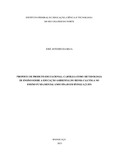Proposta de produto educacional: cartilha como metodologia de ensino sobre a educação ambiental do bioma caatinga no ensino fundamental anos finais em Ipanguaçu/RN

Visualizar/
Data
2023-08-01Autor
Silva, José Antonio
http://lattes.cnpq.br/9195156873250070
Metadado
Mostrar registro completoResumo
This work proposes the use of an educational product, an interactive booklet, as a didactic
resource for teaching and learning about Environmental Education in the Caatinga biome. The
educational product was developed on the basis of a learning diagnosis questionnaire with
students from the 8th and 9th grades of the Escola Municipal Professora Francisca da Salete
Ribeiro Barreto in the municipality of Ipanguaçu/RN. The booklet covers fauna, flora,
medicinal potential, native bees and global warming, all of which are laid out in such a way
that students can reflect on the local reality. It features clickable items, directing students to
websites and news articles that will help them delve deeper into the subject. The Caatinga
Quiz app, which offers quizzes and memory games about the Caatinga, was used to check
learning and fix the content. As a methodology for validating the booklet, an evaluation
questionnaire was administered to the teachers. According to the teachers' evaluation, this
product, previously planned and adapted to the students' reality, is a resource that contributes
to training students, who are capable of making transformations on the spot through conscious
actions. There was also a deficiency in the students' perception of the Caatinga biome, as they
didn't show any knowledge of simple aspects or made confusions with situations and practices
from their own lives that weren't related to the subject. When asked about their perception of
the importance of preserving the caatinga biome, only 11 of the 65 students interviewed were
able to answer. With regard to the native bees of the caatinga, 52.3 said they knew them and
47.7 said they didn't. When they were asked to name the species they knew, they confused
wasps and bees and the species most often mentioned was the Africanized honeybee Apis
mellifera, popularly known to them as the Italian bee.



